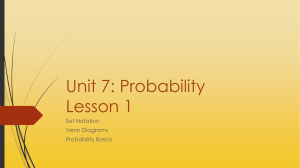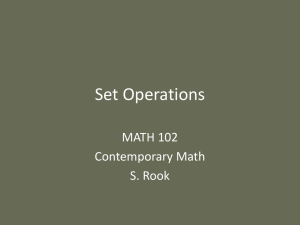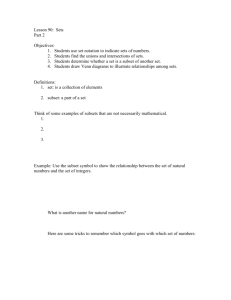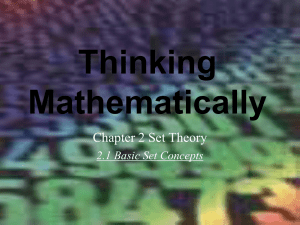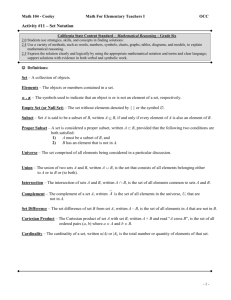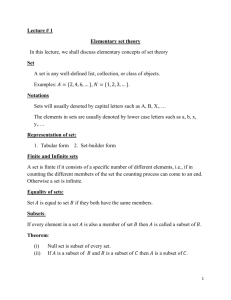subset notation
advertisement
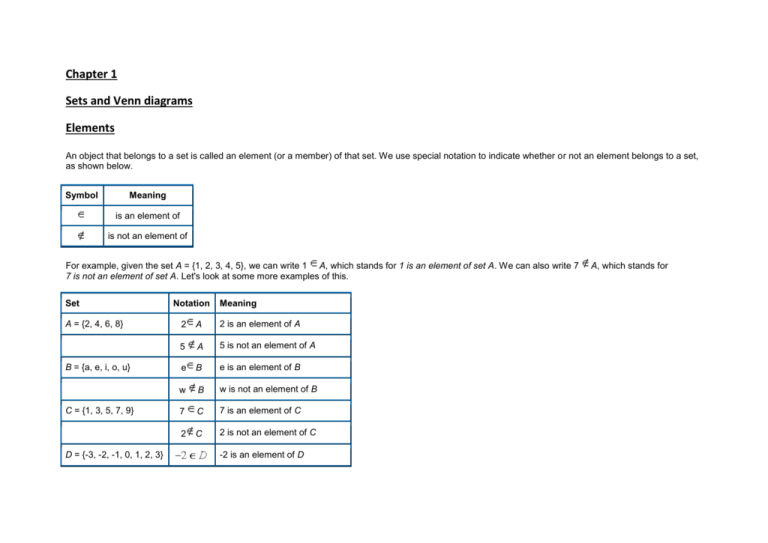
Chapter 1
Sets and Venn diagrams
Elements
An object that belongs to a set is called an element (or a member) of that set. We use special notation to indicate whether or not an element belongs to a set,
as shown below.
Symbol
Meaning
is an element of
is not an element of
For example, given the set A = {1, 2, 3, 4, 5}, we can write 1 A, which stands for 1 is an element of set A. We can also write 7
7 is not an element of set A. Let's look at some more examples of this.
Set
A = {2, 4, 6, 8}
B = {a, e, i, o, u}
C = {1, 3, 5, 7, 9}
D = {-3, -2, -1, 0, 1, 2, 3}
Notation
Meaning
2
A
2 is an element of A
5
A
5 is not an element of A
e
B
e is an element of B
w
B
w is not an element of B
7
C
7 is an element of C
2
C
2 is not an element of C
-2 is an element of D
A, which stands for
One-half is not an element of D
Determine if the given item is an element of the set.
Set
Item Is an element?
R = {2, 4, 6, 8}
10
S = {2, 4, 6, 8, 10}
10
D = {English alphabet}
m
D = {English alphabet}
X = {prime numbers less than 10}
9
A = {even numbers}
8
Summary: An object that belongs to a set is called an element (or a member) of that set. We use special notation to indicate whether or not an element
belongs to a set: (
),
Definition:
The complement of a set A, denoted by A', is the set of elements which belong to
but which do not belong to A.
The Complement
The complement of set A is denoted by A', You can also say "complement of A in
using this notation.
", or "A-prime". We can now label the sets in example 1
Example 1: Given = {students who attend The Kewl School} and A = {students in Mrs. Glosser's class}. What is the set of all students
who attend The Kewl School that are not in Mrs. Glosser's class?
Analysis:
The relationship between these sets is illustrated in the Venn diagram below.
Answer:
The shaded area outside A represents A', which is all students who attend The Kewl School that are not in Mrs. Glosser's
class.
Another way to think of the complement of a set is as follow:
Given set A, the complement of A is the set of all elements in the universal set
, that are not in A.
Let's find the complement of a set of numbers.
Example 2: Given
Answer:
= {single digits} and B = {0, 1, 4, 5, 6, 7, 8}, find the complement of B.
B' = {2, 3, 9}
Thus B' is the set of all numbers in
that are not in B. Using set-builder notation, we can write: B' = { x | x
In examples 3 through 5, the universal set is the English alphabet.
and x
B}
Example 3: Given
= {a, b, c, ..., x, y, z} and X = {a, b, c, d, e}, find X'.
Analysis:
X' would consist of all letters in the English alphabet that are not in X. This is shown in the Venn Diagram below.
Answer:
X' = {f, g, h, ..., x, y, z}
Example 4: Given
= {a, b, c, ..., x, y, z}, X = {a, b, c, d, e} and Y = {e, f, g}, find Y'.
Analysis:
Y' would consist of all letters in the English alphabet that are not in Y. This is shown in the Venn Diagram below..
Answer:
Y' = {a, b, c, d, h, i, j, ..., x, y, z}
Subset:
Example 1: Given A = {1, 2, 4} and B = {1, 2, 3, 4, 5}, what is the relationship between these sets?
We say that A is a subset of B, since every element of A is also in B. This is denoted by:
A Venn diagram for the relationship between these sets is shown to the right.
Answer:
A is a subset of B.
Another way to define a subset is:A is a subset of B if every element of A is contained in B. Both definitions are demonstrated in the Venn diagram
above.
Example 2: Given X = {a, r, e} and Y = {r, e, a, d}, what is the relationship between these sets?
We say that X is a subset of Y, since every element of X is also in Y. This is denoted by:
A Venn diagram for the relationship between these sets is shown to the right.
Answer:
X is a subset of Y.
Example 3: Given P = {1, 3, 4} and Q = {2, 3, 4, 5, 6}, what is the relationship
between these sets?
We say that P is not a subset of Q since not every element of P is
not contained in Q. For example, we can see that 1 Q. The
statement "P is not a subset of Q" is denoted by:
Note that these sets do have some elements in common. The
intersection of these sets is shown in the Venn diagram to the right.
Answer:
P is not a subset of Q.
Intersection:
Example 1:
Analysis:
Solution:
Let X = {1, 2, 3} and Let Y = {3, 4, 5}. What elements do X and Y have in common?
We will draw a Venn diagram of two overlapping circles. Elements that are common to both sets will be placed in the middle
part, where the circles overlap.
Explanation: The circle on the left represents set X and the circle on the right represents set Y. The shaded region in the middle is what they
have in common. That is their intersection. The intersection of sets X and Y is 3.
The Venn Diagram in example 1 makes it easy to see that the number 3 is common to both sets. So the intersection of X and Y is 3, and this is
written as:
X ∩ Y = {3}
Definition:
The intersection of two sets, X and Y, is the set of elements that are common to both X and Y. It is denoted by X ∩ Y, and is read "X
intersect Y".
So the intersection of two sets is the set of elements common to both sets. Let's look at some more examples of intersection.
Example 2: Let = {counting numbers}, P = {multiples of 3 less than 20} and Q = {even numbers less than 20}. Draw and label a Venn
diagram to show the intersection of P and Q.
Analysis:
Start by filling in the elements in the intersection. Since P = {3, 6, 9, 12, 15, 18} and Q = {2, 4, 6, 8, 10, 12, 14, 16, 18}, we know
that 6, 12 and 18 will be filled in first.
Solution:
Notation:
P ∩ Q = {6, 12, 18}
Example 3: Let
Analysis:
= {animals}, A = {dogs} and B = {cats}. Draw and label a Venn diagram to show the intersection of A and B.
Sets A and B do not overlap. These sets are disjoint, and have no elements in common.
Solution:
Notation:
A ∩ B= Ø
Two sets A and B are disjoint if their intersection is null. This is denoted by A ∩ B = Ø, where Øis the null orempty set.
Recall that a Universal Set is the set of all elements under consideration, denoted by capital . All other sets are subsets of the universal set.
So in each example above, the circles are subsets of the Universal set. We have examined the intersection of overlapping sets, and of disjoint
sets. Let's look at the intersection of one set contained within another.
Example 4:
Let C = {a, r, e} and D = {f, a, i, r, e, s, t}. Draw and label a Venn diagram to show the intersection of sets C and D.
Analysis:
C is a subset of D. Recall that this is denoted by C
D.
Solution:
Explanation: It turns out that C ∩ D = {a, r, e}, which is equal to the set C.
In example 4, since C
D , we get that C ∩ D = C. This relationship is defined below.
Union
Example 1:
In Greenville Middle School, two classes will be merged into one in order to reduce costs. If the students in Band and Chorus
are combined into one new class, then which students will be in that class?
Given:
Given = {Sam, Kyesha, Derek, Lorrie, Robin, Raúl, Shirley, Nathan, Chris, Dana}, Band = {Sam, Lorrie, Raúl, Derek} and
Chorus = {Robin, Derek, Kyesha}, find Band Chorus.
Analysis:
This problem is asking us to find the union of Band and Chorus. To solve this problem, we must list all students who are in
Band, in Chorus, or in both.
Solution:
Explanation: Band
Chorus = {Sam, Lorrie, Raúl, Derek, Kyesha, Robin}
Note that Derek is in both sets, and therefore, in their intersection. However, Derek is only written once in the union.
Definition: The union of two sets A and B, is the set of elements which are in A or in B or in both. It is denoted by A
B, and is read "A union B".
Let's compare union and intersection.
Union
Intersection
written as
A
A
read as
A union B
A intersect B
meaning of
A or B or both
A and B
B
B
Look for the combine all elements elements in common to both
A union is often thought of as a marriage. We use "and" for intersection" and "or" for union. Let's look at some more examples of the union of two sets.
Example
2:
Let = {counting numbers}, P = {multiples of 3 less than 20} and Q = {even numbers less than 20}. Draw and label a Venn
diagram to show the union of P and Q.
Analysis:
Shade elements which are in P or in Q or in both. The shaded region in the Venn diagram below indicates P
Q.
Solution:
Notation:
P
Q = {2, 3, 4, 6, 8, 9, 10, 12, 14, 15, 16, 18}

